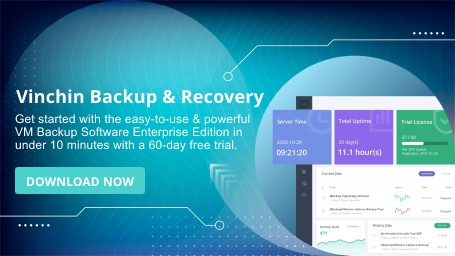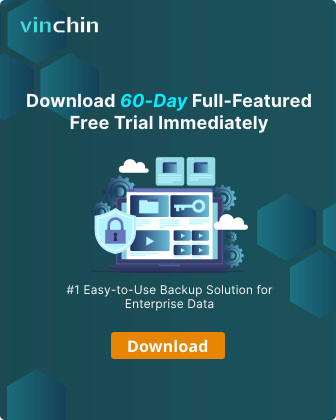-
Why disaster recovery (DR)?
-
RTO and RPO
-
Choosing the right AWS DR strategy types
-
Efficient and Secure AWS DR with Vinchin Backup & Recovery
-
DR strategy AWS FAQs
-
Conclusion
With the deepening of enterprise digital transformation, more and more companies are choosing to deploy business-critical applications to the cloud, and Amazon Web Services (AWS), as the world's leading cloud computing platform, provides a wealth of Disaster Recovery (DR) capabilities to help enterprises cope with a variety of possible disaster scenarios. Developing an appropriate AWS disaster recovery strategy not only ensures business continuity, but also reduces the risk of data loss and improves an organization's ability to respond to unexpected events.
Why disaster recovery (DR)?
Disaster recovery is an important part of every organization's information technology strategy. No organization can predict all possible disaster events - from natural disasters to cyber-attacks, even human error can have a significant impact on business. The purpose of disaster recovery is to ensure that in the event of a business disruption, the business is able to resume operations in the shortest possible time, minimize data loss, and minimize the impact on customers and the brand.
Risks faced by businesses include:
Business interruption: Technical failures, network outages or data loss can bring business to a halt, impacting revenue and customer satisfaction.
Data loss: Improper backups or storage failures can lead to the loss of critical data, posing compliance and legal risks.
Damage to brand reputation: Prolonged downtime or service interruptions can lead to a decline in customer trust, affecting an organization's market position.
By implementing a disaster recovery strategy, organizations can ensure rapid recovery and business continuity after a disaster, while protecting customer data and sensitive information.
RTO and RPO
Before designing a disaster recovery strategy in AWS, organizations must first understand the Recovery Time Objective (RTO) and Recovery Point Objective (RPO).
Recovery Time Objective (RTO): refers to the maximum amount of time it takes from the onset of a disaster to the restoration of services. RTO is a key indicator of an organization's tolerance for business interruption.
Recovery Point Objective (RPO): refers to the maximum acceptable data loss time. That is, the maximum tolerance for data loss in the event of a disaster.
With RTO and RPO clearly defined, organizations can choose the appropriate AWS services and architectures based on these objectives to achieve different levels of disaster recovery requirements.
Choosing the right AWS DR strategy types
AWS offers a variety of disaster recovery strategies, and organizations can choose the most appropriate option based on their needs, budget, and business criticality. Here are a few common disaster recovery strategies:
Backup and Restore
This is the most basic disaster recovery strategy. Businesses regularly back up their data to a storage service such as Amazon S3 or S3 Glacier. In the event of a disaster, organizations can restore data from the backups.
⚡Pros: Low cost and simple to implement.
⚡Cons: Longer recovery time, usually for business scenarios that don't require fast recovery.
Pilot Light (Minimum operating environment)
Under this strategy, organizations deploy their most critical business environments to AWS, but keep them minimal. In the event of a disaster, the organization can quickly scale that environment and restore a full production environment.
⚡Pros: Scales faster in the event of a disaster and is suitable for most organizations.
⚡Cons: The need to reserve a certain amount of computing and storage resources for the base environment increases some of the costs.
Warm Standby
The Warm Standby strategy requires organizations to keep core services on AWS and running continuously, albeit under a lighter load. When disaster strikes, organizations can quickly scale resources to restore business functions.
⚡Pros: Faster recovery times than Pilot Light for most businesses that require shorter recovery times.
⚡Cons: Slightly higher cost than Pilot Light because of the need to maintain a portion of compute resources and storage services.
Multi-Activity (Active-Active)
For applications that require high availability and zero recovery time, the Multi-Active strategy is to run the production environment in multiple AWS regions simultaneously. Each region is capable of handling business requests, ensuring business continuity. In the event of a failure, traffic is automatically switched to another available region with virtually no recovery time.
⚡Pros: Provides near-zero recovery time, suitable for business-critical systems.
⚡Cons: Higher cost, requires deployment of resources in multiple regions and efficient load balancing.
Efficient and Secure AWS DR with Vinchin Backup & Recovery
When developing a suitable AWS disaster recovery strategy, enterprises need to consider not only the technical capabilities of different recovery options but also evaluate the overall solution's efficiency, cost, and ease of operation. While AWS offers a variety of disaster recovery strategies, such as Backup & Restore, Pilot Light, Warm Standby, and Multi-Active, enterprises still face challenges in practical application, such as how to efficiently and economically manage large amounts of data and how to quickly restore business services while ensuring data security.
Vinchin Backup & Recovery provides an excellent solution designed specifically for AWS environments, offering powerful EC2 and S3 data backup and recovery capabilities. It helps enterprises ensure data security, optimize recovery processes, and reduce operational costs.
To address the threats of ransomware and other malicious attacks, Vinchin includes built-in ransomware protection mechanisms that monitor I/O operations in real time and intercept unauthorized data modification requests, ensuring the integrity and security of backup data. This provides additional protection for enterprises against potential cyberattacks, preventing the loss of critical data.
In addition, Vinchin excels in recovery capabilities, enabling enterprises to quickly recover data on AWS EC2 and S3. After a disaster, Vinchin ensures that businesses can restore operations in the shortest possible time, minimizing downtime and data loss. Its efficient backup and recovery strategy is particularly suitable for enterprises that require rapid recovery, ensuring business continuity and minimizing the impact on customers.
Most importantly, Vinchin offers flexible cost control options. By supporting incremental and automated backups, enterprises can optimize the use of storage and computing resources according to their needs, lowering operational costs. Therefore, no matter the size of the enterprise, Vinchin provides an efficient, scalable, and cost-effective AWS backup and recovery solution.
Vinchin Backup & Recovery's operation is very simple, just a few simple steps.
1. Select the backup source object storage
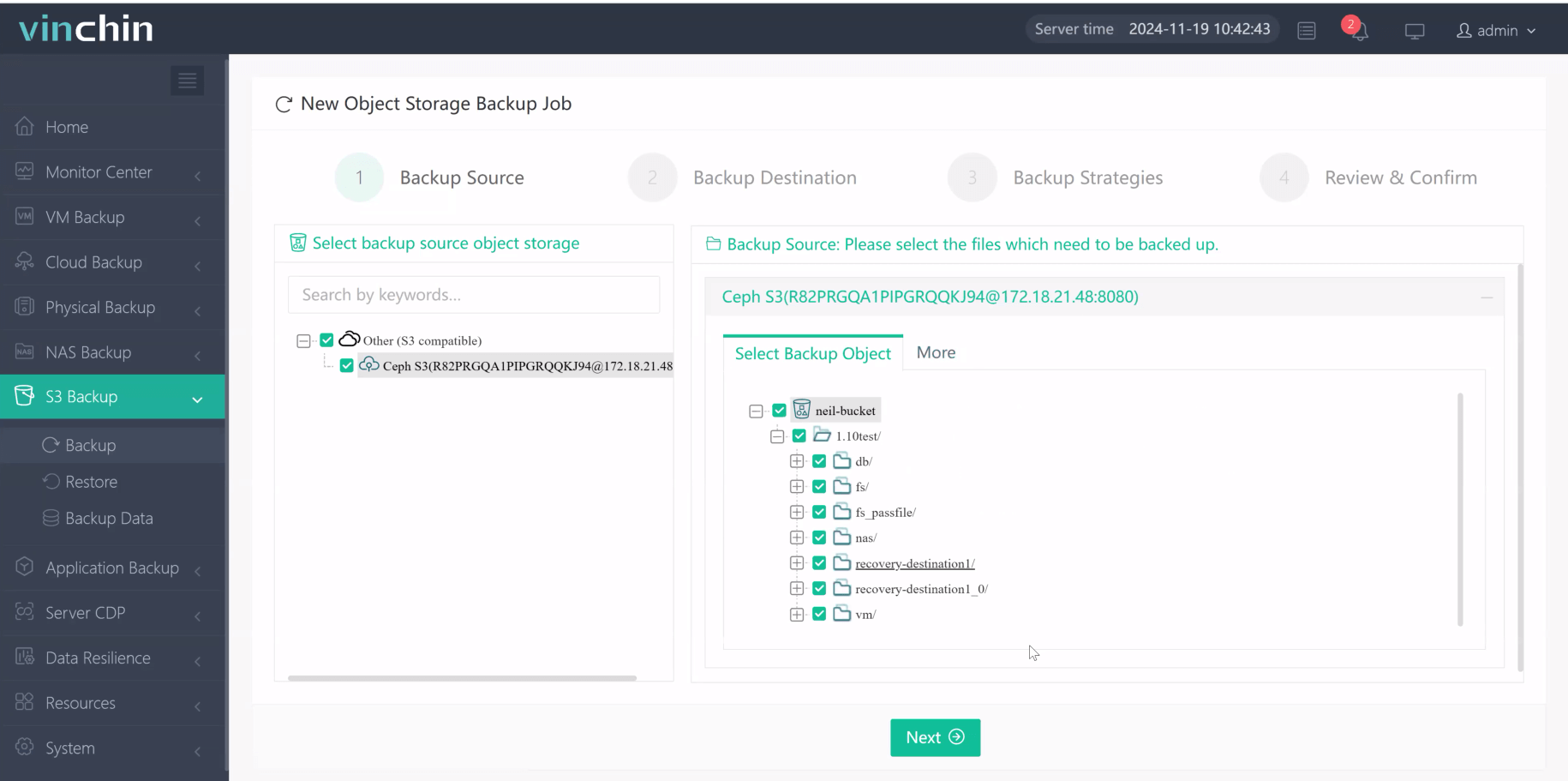
2. Then select backup destination
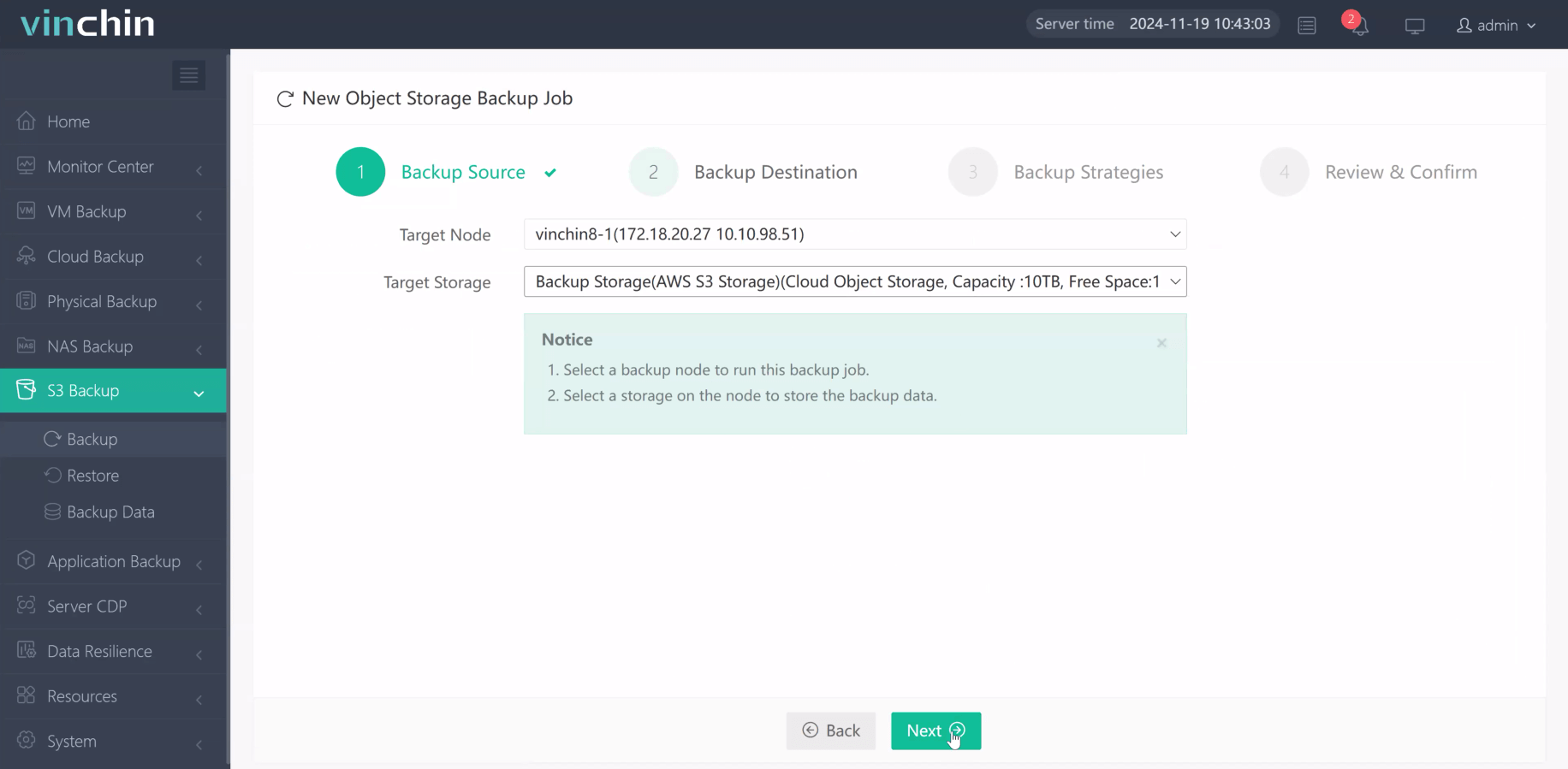
3. Select strategies
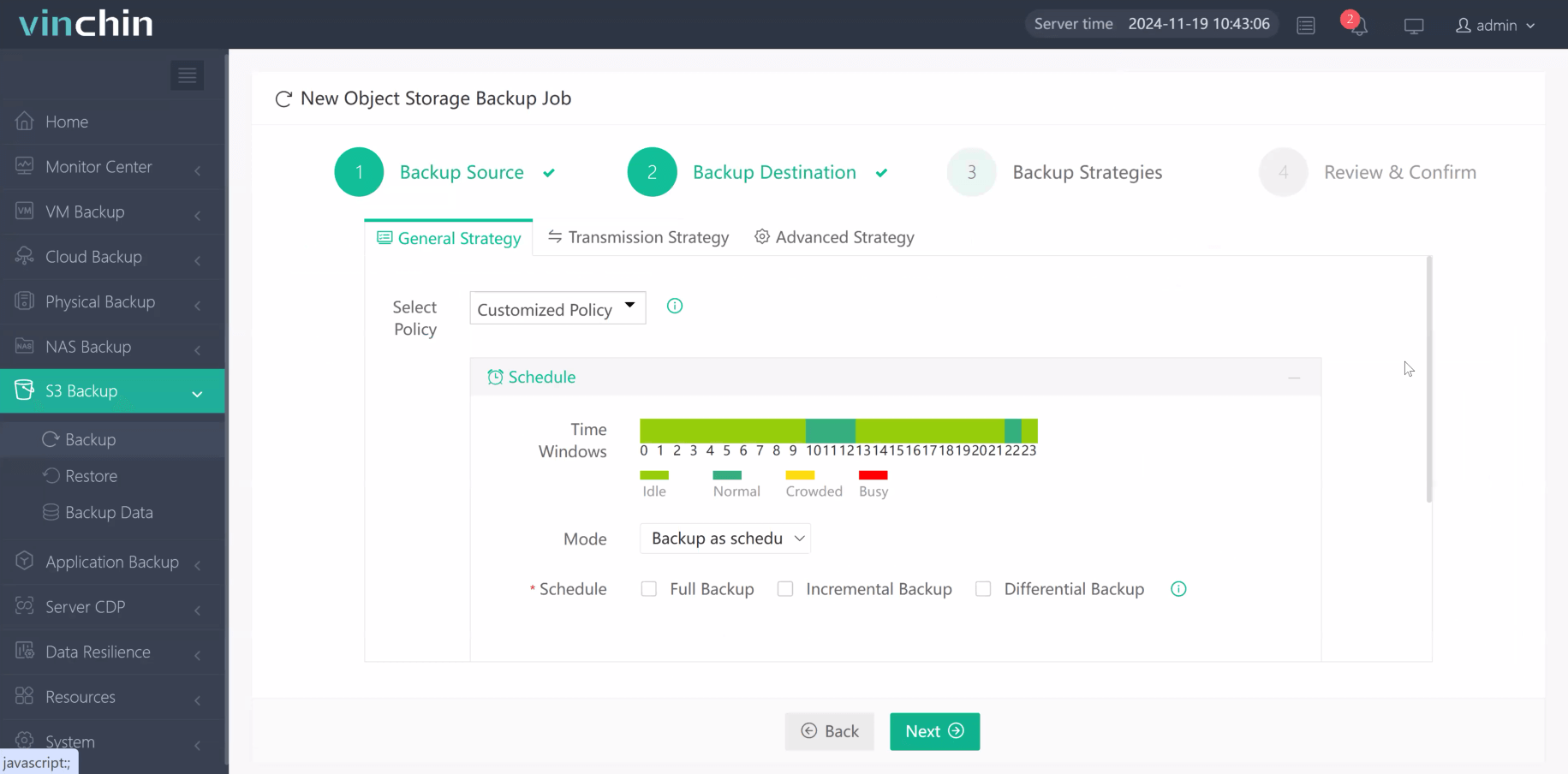
4. Finally submit the job
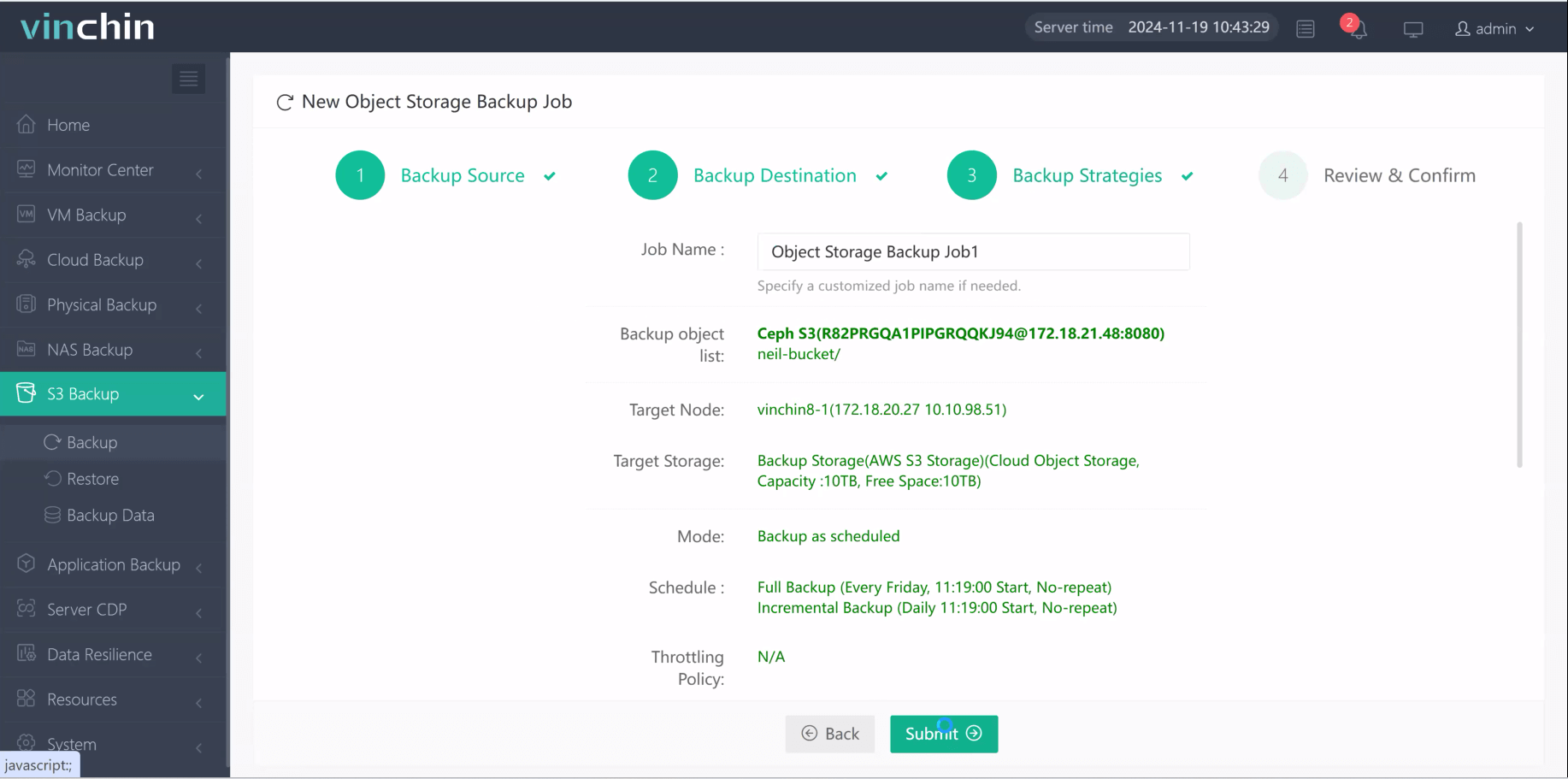
Overall, Vinchin's backup and recovery solution for AWS environments combines efficiency, security, and flexibility, making it an ideal choice for enterprises facing disaster recovery challenges. Vinchin offers a 60-day free trial for users to experience its features in a real-world setting. For more information, please contact Vinchin directly.
DR strategy AWS FAQs
Q1: Is a Disaster Recovery Drill necessary?
A1: Yes, it is important to conduct disaster recovery drills on a regular basis to help validate the effectiveness of your DR plan, ensure that your team is familiar with the process, and identify any potential issues or improvements.
Q2: What do I need to do to prepare to implement an AWS Disaster Recovery strategy?
A2: Start by identifying your RTO and RPO goals, then select the appropriate AWS service (e.g. Amazon S3, Amazon Glacier, AWS CloudFormation, etc.), develop a detailed plan, and regularly test and update your DR strategy.
Conclusion
In conclusion, a robust AWS disaster recovery strategy is essential for ensuring business continuity, data protection, and minimal operational disruption. With various recovery options and the added benefits of Vinchin Backup & Recovery, businesses can achieve efficient, secure, and cost-effective disaster recovery solutions.
Share on:


